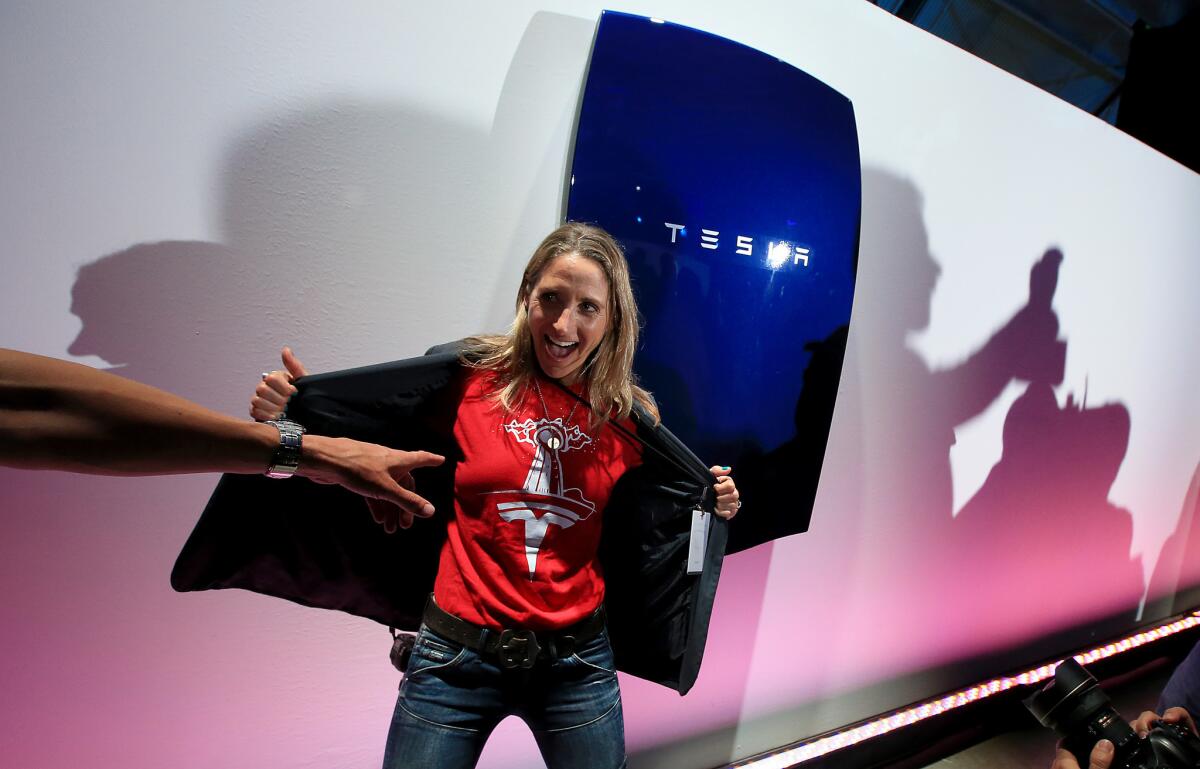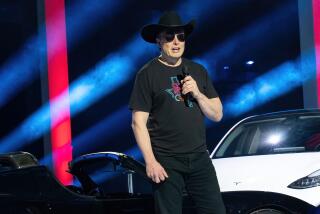Why Tesla is making a power play into batteries for home, business

Carrie Lederer, a Santa Monica resident and Tesla car owner, poses with the Powerwall during an event at the company’s plant in Hawthorne on Thursday.
Billionaire Elon Musk’s Tesla Motors Inc. unveiled a line of inexpensive residential and commercial energy storage systems at a rock concert-like gala Thursday night at the company’s design studio in Hawthorne.
The battery-based systems are expected to make solar power systems more efficient, provide backup power during blackouts and potentially give remote villages in undeveloped countries affordable access to electricity.
What is the product?
The Tesla Powerwall is a rechargeable lithium-ion battery about the size and thickness of a home refrigerator door. It can be bolted to the wall of a garage or home. It stores energy from rooftop solar panels or even the electric grid.
Tesla sees three uses for the Powerwall:
1. Load shifting: Depending on the utility and rate plan, homeowners and small businesses could charge batteries at night, when there is surplus generation and rates are cheap, and then use the power during the day, when there is a heavy load on the grid and rates are highest.
2. Pairing with solar panels: This will increase consumption of solar power by having the battery hold surplus solar energy not used at the time it is generated for use at night or when the sun is not shining.
3. Backup power: Even a single charged battery will keep major appliances, lights and computers running for hours in an outage.
How much power will the Powerwall store?
One version will sell for $3,500 plus installation and will store 10 kilowatt-hours, which could supply much of a typical home’s energy needs for 10 hours. A smaller 7 kilowatt-hour battery will sell for $3,000 plus installation. Deliveries begin in late summer.
What about businesses?
Tesla is using the same technology in its Powerpack, a scalable battery system that can let businesses store much larger amounts of energy. Amazon, Target and Wal-Mart already have pilot projects using the system. All of the energy used for Tesla’s Thursday night event came from solar panels and was stored in the new battery system.
Tesla also is working with Southern California Edison and other utilities to create massive battery storage systems that can help smooth out peaks and valleys in electricity demand on the grid.
Won’t this disrupt the electric grid?
If the Tesla battery system and those by other companies are widely adopted, experts say that could contribute to a “utility death spiral,” in which fewer and fewer customers stick with utility-generated power, thereby raising the rates of those who remain captive to the larger system.
Why would an automaker get into this?
Tesla Motors is not a conventional automaker. It sells only electric cars that run on battery power. Tesla is building a giant battery factory in Nevada. It is leveraging its research into big battery packs for cars to build stationary storage.
Musk has hinted he might change the name of the company to Tesla Energy, noting he has secured the TeslaEnergy.com domain name. He now describes the business as an energy innovation company.
With Tesla Energy, Tesla is amplifying its efforts to move away from fossil fuels to a sustainable energy future.
Why does Musk care?
He sees this as a money maker. Storing electricity efficiently, inexpensively and safely is a problem that has vexed the power industry since electricity was first harnessed. Companies that solve the problem stand to make big profits. As news of Tesla’s plan started to trickle out, its shares have soared 19% since April 1 to $223.542 in trading today, adding billions of dollars to the automaker’s stock market value. Shares of SolarCity, the Tesla partner where Musk serves as chairman, have risen by a similar amount.
Does Musk have bigger reasons?
One of the unifying themes of Musk’s ventures is their potential to affect humanity. He sees SpaceX, his rocket company, as eventually allowing for the colonization of Mars. Musk has said space colonization is crucial for the survival of the human species. He sees electric cars as the next step in transportation because they dramatically cut greenhouse gas emissions.
In virtually everything he does, Musk expresses concern about climate change and carbon emissions. In his presentation Thursday, he said about one-third of the fossil fuel consumed in the U.S. is used in transportation and another third goes to electricity production. The U.S. electric power sector alone produces more than 2 billion metric tons of C02. Providing a path for people to slash those emissions through the combined use of solar power and battery-based energy storage addresses what Musk sees as a solution to one of society’s biggest problems.
Follow me: @LATimesJerry, Facebook and Google+.







